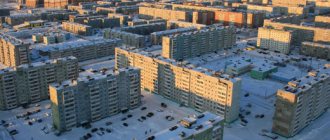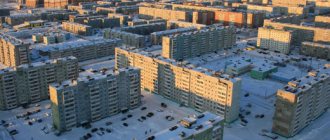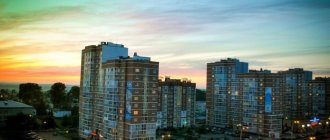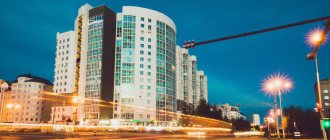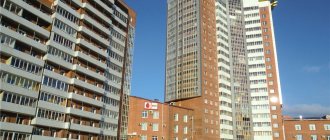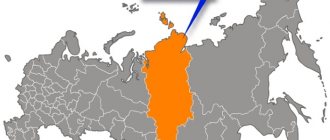Kuban is the largest river in the North Caucasus. The Bolshoy Zelenchuk River flows into it. A large cape formed at the confluence. It was on it that Nevinnomyssk was founded. This situation is reflected in the city coat of arms - two blue stripes converge on a golden field, forming a green triangle. The city is the starting point for many tourist routes in the North Caucasus.
Coat of arms of Nevinnomyssk
Nevinnomyssk on the map
Nevinnomyssk is located in the Ciscaucasia region on an elevated part of the Stavropol Territory, along the banks of the calm Kuban River, which merges with a watercourse called Bolshoi Zelenchuk. The city is located 55 km from Stavropol at an altitude of 343 m above sea level. m.
It covers an area of more than 100 km2. The settlement received its name thanks to the Nevinka River, which flows near the station. Ust-Nevinka.
Despite its small territory, Nevinnomyssk is divided into the following districts:
- PRP;
- Center;
- Head;
- spare parts;
- Red Village;
- MZHK;
- Old city;
- Comet;
- Mill;
- Pravokubansky;
- Rozhdestvenka;
- House of Life;
- Factory.
The city has moderate continental climatic conditions. Winters here are long and mild with average January temperatures of 80 C. Summers are fleeting and hot. The average July temperature is +160 C.
On the Innocent Cape
The city of Nevinnomyssk is located in the Ciscaucasia, 70 kilometers south of Stavropol. From a geographical point of view, the area is called the Stavropol Upland. Urban development stretches along the left bank of the Bolshoi Zelenchuk River and the right bank of the Kuban River. The internal floodplain area between the rivers is not built up and is a forested area. This is a favorite vacation spot for city residents.
There are two main versions regarding the history of the origin of the city's name. The first belongs to the military historian Vasily Potto. More than a hundred years ago, he studied the Mozdok archive and discovered a circular dated 1784. It followed from it that the river flowing into the Kuban was ordered to be called Innocent. It already had a name given by the soldiers, but it sounded obscene. Later, a village was founded on the cape, at the confluence of the Nevinnaya River and the Kuban. The name Nevinnomyssk was assigned to it.
The author of the second version is the Stavropol local historian V. Kolesnikov, who wrote the book “The Past of the Innocent Cape”. In his opinion, the name of the settlement was given by Count Pavel Potemkin in 1784. The reason was the nearby mountain "Aryuv-kyz". Translated from Nogai it means “beautiful girl”. There is a legend associated with the mountain, according to which an innocent girl died after being married to an unloved man.
Steles framing the city
Steles rise on both sides of the city:
- One of them stands at the entrance to the village from the Stavropol direction. The monument is a stone structure, in the lower part of which the name of the city is written, and on one side of the monument there is a high pillar.
- Another memorial plaque is located at the entrance to the settlement on the side of Mineralnye Vody. It is dedicated to workers in the energy industry and the production of energy. The stele was installed on the street. Power engineers, not far from the hydroelectric power station.
A monument in the form of a male figure was erected nearby in 2008. In one of his palms lies a gear with outgoing energy radiation, and in the other he holds the sun. The man's face is turned to the sky. The monument is made of stainless steel and covered with silver paint.
The statue stands on a high pedestal, on which the word “GRES” is written in huge font.
The procedure for submitting and receiving applications and complaints in court
A plaintiff is a person who goes to court to protect his violated or disputed right. The defendant is the person against whom the claim is brought, that is, the person who, in the opinion of the plaintiff, violates or challenges his rights and interests protected by law. Naturally, each of the parties has opposing interests in the lawsuit: the plaintiff insists on satisfying his demands, and the defendant objects to them. The plaintiff and defendant are “ interested parties ” (this is a legal term) because they have a personal interest in resolving the dispute. They act in the process on their own behalf, bear the legal costs of the case, and are subject to the legal force of the court decision.
In addition to the plaintiff and defendant, persons who have independent claims on the subject of the dispute may take part in the process, as well as in the event that the decision in the case may affect their rights or obligations in relation to one of the parties. Such participants in the process are called third parties. Both individuals (citizens, foreigners, stateless persons) and legal entities can act as parties and third parties in civil proceedings, that is, organizations that have separate property, can acquire property and personal non-property rights in their own name, bear duties, to act in court as a plaintiff and defendant. To participate in the process, citizens and organizations must have civil procedural capacity, that is, the ability to have civil procedural rights and obligations. Civil procedural legal capacity is recognized by law equally for all individuals, as well as for organizations enjoying the rights of a legal entity, and arises for individuals from the moment of birth, and for legal entities - from the moment of their creation.
Minors under the age of 14 , as well as individuals recognized as incompetent due to mental illness or dementia, do not participate in civil proceedings, and their rights and interests protected by law are protected in court by their legal representatives - parents, adoptive parents or guardians. A minor aged 16 to 18 years can personally exercise his procedural rights and perform procedural duties in court from the time of marriage or declaration of full legal capacity (emancipation). Minors aged 14 to 18 years , as well as individuals recognized as having limited legal capacity due to alcohol or drug abuse, participate in the process together with their legal representatives - parents, adoptive parents, trustees. In cases provided for by law, in cases arising from labor, collective farm and marriage-family legal relations, and from transactions related to the disposal of earnings received, minors have the right to personally defend in court their rights and interests protected by law. The involvement of legal representatives of minors in such cases depends on the discretion of the court.
To protect their rights and interests, parties to civil proceedings are endowed with significant procedural rights. They can get acquainted with the case materials, make extracts from them, make copies, challenge the judges, prosecutor, expert, translator, court secretary, members of the public, present evidence, participate in the study of evidence, ask questions to other persons participating in the case, witnesses and experts, give oral and written explanations to the court, file motions and present their arguments and considerations on all issues arising during the trial, as well as object to motions, arguments and considerations of other persons participating in the case, appeal decisions and rulings of the court, and so on Further.
The court does not initiate civil cases on its own initiative. Civil cases are initiated either at the request of the person himself, seeking protection of his right or interest protected by law; or at the request of the prosecutor; or at the request of government bodies, trade unions, enterprises, institutions, organizations, and so on.
In cases of claim proceedings, statements of claim are filed, and in cases arising from public relations and in cases of special proceedings - complaints and statements.
A judge can consider cases either individually or collectively. Justices of the peace hear cases only individually.
The magistrate considers as a court of first instance:
- cases of issuing a court order;
- cases of divorce, if there is no dispute between the spouses about children;
- cases of division of jointly acquired property between spouses with a claim price not exceeding fifty thousand rubles;
- other cases arising from family law relations, with the exception of cases of challenging paternity (maternity), establishing paternity, deprivation of parental rights, limiting parental rights, adoption of a child, other cases of disputes about children and cases of recognition the marriage is invalid;
- cases on property disputes, with the exception of cases on inheritance of property and cases arising from relations on the creation and use of results of intellectual activity, with the cost of the claim not exceeding fifty thousand rubles;
- cases to determine the procedure for using property.
The statement of claim is submitted to the court in writing. The law stipulates what information must be contained in the statement of claim and prescribes its mandatory form.
The application must indicate:
- Name of the court to which the application is filed;
- The name of the plaintiff, his place of residence or, if the plaintiff is an organization, its location, as well as the name of the representative and his address, if the application is submitted by a representative;
- The name of the defendant, his place of residence or, if the defendant is an organization, its location;
- What is the violation or threat of violation of the rights, freedoms or legitimate interests of the plaintiff and his demands;
- The circumstances on which the plaintiff bases his claims and evidence supporting these circumstances;
- The price of the claim, if it is subject to assessment, as well as the calculation of the amounts collected or disputed;
- Information on compliance with the pre-trial procedure for contacting the defendant, if this is established by federal law or provided for by the agreement of the parties;
- List of documents attached to the application.
The application may indicate telephone numbers, fax numbers, email addresses of the plaintiff, his representative, the defendant, other information relevant to the consideration and resolution of the case, as well as the plaintiff’s requests. Indicating the addresses of the parties and other persons involved in the case is essential for determining the jurisdiction of the case (see below for this), as well as for sending subpoenas and notices. In cases where the law provides for the possibility of declaring a search for the defendant (Articles 119, 120 of the Code of Civil Procedure of the Russian Federation), the plaintiff is not obliged to give the exact address of the defendant, but may limit himself to indicating his last known place of residence. The application is signed by the plaintiff or his representative. A statement of claim filed by a representative must be accompanied by a power of attorney or other document certifying the authority of the representative. After submitting a statement of claim, complaint or application to the court in a special proceeding, the judge is obliged to formalize his decision to initiate legal proceedings in the form of a ruling and order pre-trial preparation.
All determinations at this stage are made in writing.
If the judge refuses to accept the application or returns or leaves the application without movement, then this decision is formalized in the form of a ruling, a copy of which is given to the applicant.
Definitions must contain the following information:
- Time and place of delivery;
- The name of the court that issued the ruling, the names of the composition of the court and the secretary of the court session;
- List of persons participating in the case and the subject of the dispute;
- The issue on which the determination is made;
- The reasons on which the court came to its conclusions and reference to the laws that guided the court;
- Court statement;
- The procedure and deadline for appealing (this point is indicated in those determinations that can be appealed).
If the court's ruling does not contain any of the listed elements, then it is considered to be made in gross violation of procedural law. After the application has reached the judge (it can be delivered in person or sent by mail - this is permitted by law), the judge, in accordance with Articles 133, 134 of the Code of Civil Procedure of the Russian Federation, decides whether to accept it or refuse to accept it.
Article 134 of the Code of Civil Procedure of the Russian Federation establishes an exhaustive list of grounds for refusing to accept an application, that is, the judge does not have the right to refuse on any other grounds. If the judge’s ruling refuses to accept the application and the applicant does not agree with this, he has the right to appeal this ruling to a higher court by filing a private complaint (see sample below). A private complaint is filed through the office of the court whose ruling refused to accept the application, and the office itself then forwards the complaint and materials to a higher court for consideration. A private complaint must be filed (or mailed) within ten days from the date of the decision to refuse to accept the application. If this deadline is missed for a good reason (illness, business trip, etc.), then in a private complaint you must ask for the restoration of the missed deadline for filing a private complaint, attaching a supporting document to it. A private complaint is not subject to state duty.
Citizens may conduct their cases in court in person or through representatives. The right to conduct a case in judicial authorities through a representative belongs to the persons participating in the case: parties, third parties, both with and without independent claims. Judicial representation is possible in any civil cases and at all stages of the civil process: in the court of first instance, when reviewing court decisions in cassation and supervisory procedures, in newly discovered circumstances, in enforcement proceedings. Conducting a case with the help of a representative does not deprive a party of the right to personally participate in the process together with his representative.
If it is necessary for the court to receive personal explanations, the court has the right to summon a party even if there is a representative (in claims for divorce; in cases of establishing paternity, etc.).
Article 49 of the Code of Civil Procedure of the Russian Federation establishes that legally capable persons who have duly formalized authority to conduct the case may be representatives in legal proceedings (with the consent of the person being represented). Judges, investigators, and prosecutors cannot be representatives in court, except when they participate in the process as representatives of relevant bodies or legal representatives. Most often, lawyers act as representatives in court (we will dwell further on the features and principles of the participation of a lawyer in civil proceedings).
There are two types of representation - by force of law and by proxy.
The rights and legally protected interests of incapacitated citizens, citizens who do not have full legal capacity, and citizens recognized as having limited legal capacity are protected in court by their parents, adoptive parents, guardians or trustees, who present to the court documents certifying their powers. Legal representatives perform on behalf of the represented all procedural actions, the right to perform which belongs to the represented, with the restrictions provided for by law (Part 1 of Article 52 of the Code of Civil Procedure of the Russian Federation).
Legal representatives do not require a special document such as a power of attorney; only a document certifying their status is sufficient, for example a child’s birth certificate. In a case in which a citizen recognized as missing in the prescribed manner must participate, a guardian appointed to protect the property of the missing person acts as his representative.
In a case in which the heir of a person who has died or was declared dead in the prescribed manner must participate, if the inheritance has not yet been accepted by anyone, a guardian appointed to protect and manage the inherited property acts as a representative of the heir. The law gives legal representatives the right to entrust the conduct of a case in court to another person chosen by them as a representative, as expressly stated in Part 3 of Article 52 of the Code of Civil Procedure of the Russian Federation. The second type of representation is by proxy. In this case, the powers of the attorney (that is, the one who was authorized) are formalized by a special document - a power of attorney, certified by a notary or the relevant official.
The powers of the representative (attorney) can also be expressed in an oral statement of the principal (that is, the one who authorizes) in court, recorded in the minutes of the court session. A power of attorney can be issued to conduct a specific business, several or all affairs of the principal, or to perform individual procedural actions. The validity period of a power of attorney cannot exceed three years, and if the period is not specified in the power of attorney, it remains valid for one year from the date of its issue. A lawyer's authority to conduct a case in court is certified by a warrant issued by a legal entity, such as the director of a law office (senior partner). Having accepted the assignment to conduct the case, the judicial representative becomes an independent participant in the civil process and is endowed with procedural rights. Thus, the representative has the right to get acquainted with the case materials, make extracts from them, file challenges, participate in the court hearing, present evidence and participate in its examination, file motions, speak in debates, and the like.
At a court hearing, the representative acts within the powers granted to him by the principal. If a judicial representative goes beyond the limits of the rights granted to him, his actions do not entail legal consequences for the principal, and court decisions (decisions, rulings) based on them are subject to cancellation by higher courts. For this reason, the activities of the representative are carried out under the control of the court, which is obliged to check the scope of his powers, whether his actions contradict the interests of the principal and the law, whether there are circumstances that exclude the possibility of his participation in court, and the like.
Powers of attorney issued by citizens can be certified both by a notary and by enterprises, institutions or organizations where the principal works or studies, a housing maintenance organization at the principal’s place of residence, the administration of a hospital hospital, or a military unit, if the power of attorney is issued to military personnel. A power of attorney issued by a citizen who is imprisoned is certified by the administration of the corresponding place of imprisonment. A power of attorney on behalf of a legal entity is issued by its head.
Museum of Local Lore
The city museum of local lore was founded in 1957 as the “Exhibition of Military Glory.” A collection of 500 items was assembled as exhibits. Eight years later, by decision of the city authorities, the exhibition was transformed into a museum of labor, military and revolutionary glory.
Since the end of the twentieth century. The institution is an independent staff structure under the Culture Committee and is called the Nevinnomyssk Local Lore and History Museum. In the same year, he was moved to a separate modern building located in a residential area of the central part of the city on the street. Gagarina 43b.
Nevinnomyssk has a rich history, which can be found in the city local history museum
There are several halls here:
- Expositional, telling about the history of the city, from its first inhabitants to the present day.
- An exhibition hall, distinguished by the fact that it has monthly changing expositions of different directions. Often exhibitions are placed in the building's lobby.
- Here they constantly conduct excursions and give lectures for city schoolchildren, students and military people.
For the exhibition dedicated to the Second World War, many new exhibition complexes were created in the historical hall. Currently, the museum collection includes about 12.3 thousand items. The institution's funds are constantly replenished thanks to local residents. The museum is open to visitors every day from 9.00 to 17.00, except Mon.
An adult entrance ticket costs 5 rubles, and for a child ticket you need to pay 2 rubles.
A FEW WORDS ABOUT THE CIVIL WAR
The introductory historical part could have ended here, but I really want to touch on the topic of the Civil War just a little bit.
With its onset, the village of Nevinnomyssk, like most villages and cities in our country, was divided into two camps. On the one hand there were workers of enterprises who fought, as usual, on the side of the Soviet regime, and on the other side there were Cossacks who preferred the side of the White Guard.
As in the film “Wedding in Malinovka,” the village repeatedly passed from hand to hand, first one, then another.
So, my great-great-grandfather on the cousin’s side, I.A. Kochubey, a hereditary Cossack, initially, immediately after being drafted, fought for the whites, and then, for ideological reasons, went over to the side of the reds.
And after some time, he had a conflict with the Soviet authorities, and already in February 1919 he was accused, first of anarchy, then of abuse of power, laxity, and ultimately, he was arrested and put under arrest. While he was under arrest and waiting for clarification of the current situation, the village was occupied by whites. After interrogation and refusal I.A. Kochubey about collaboration with the whites, he was sentenced to death by a military court and hanged.
Now there are a lot of false experts and “experts” on this period, who want to either embellish one side while denigrating the other, or vice versa.
For me, the civil war is perhaps one of the most terrible periods in history. It’s one thing when the enemy is a fascist, and quite another when the enemy is your brother or father, friend or neighbor.
Isn't this a tragedy? And I think it’s a sin to publicize on tragedy and misfortune.
That's how my great-grandfather is. He fought honestly, risked his life for the ideals that he understood and accepted, for what was dear to him and for those whom he simply loved. Maybe he even made a mistake somewhere, but there is no point in judging and, especially, condemning him for this.
Many districts, villages and towns, as well as streets and squares in different cities are named in his honor. A decent number of monuments and busts have been erected, several books have even been written and the film “Kochubey” has been filmed. By the way, at the time of his death, he was only 25 years old.
Monuments to the Cossacks
Nevinnomyssk is located in a historical area that was conquered by people at the cost of their own lives. In 2012, not far from the mass grave on the street. Revolutionary, 18, a monument to the founding Cossacks was unveiled in an official setting.
Don't miss the most popular article in the section: Metro Nizhny Novgorod. Diagram, map, description.
The sculptural complex is dedicated to the local Cossacks, who protected Art. Nevinnomysskaya in 1842 and died heroically. The monument is a massive block in the form of a worship cross, installed on a marble platform. The sculpture is topped with a steel cross.
The names of 17 dead Khoper residents are carved on the stone.
Stele on Belovo street
This example of unity not only of Russian lands, but also neighboring ones, was built in honor of the Bulgarian city - Belovo's sister city, after which the street was named. The stela was installed in a small park, which was previously a place for celebrations of Soviet youth. In addition, there is a monument to the Hero of the Soviet Union T.N. Podgorny and a memorial dedicated to the townspeople who died while eliminating the consequences of the accident at the Chernobyl nuclear power plant.
Monument to the 85mm anti-aircraft gun
The grand opening of the monument to the Anti-Aircraft Cannon took place in 1981. The Obelisk was placed on Mira Blvd. It looks like an 85mm anti-aircraft gun standing on a low cast iron platform. The pedestal is made in the form of a rectangular figure, one edge of which is higher than the other.
Due to this circumstance, the cannon is directed upward, which indicates its main purpose - to destroy as many enemy aircraft as possible. The sculptural composition reminds local residents of the hot summer of 1942, when soldiers of the 18th Artillery Division, at the cost of their own lives, recaptured their hometown from the Nazis.
Cathedral of the Intercession of the Blessed Virgin Mary
The Church of the Intercession of the Blessed Virgin Mary is considered the largest church community in the Stavropol diocese. At the same time, it can accommodate about 1.5 thousand parishioners. At the turn of the 20th and 21st centuries. the temple was elevated to the rank of a cathedral. The village of Nevinnomyssk was founded on the day of the Intercession of the Mother of God, and a holy place was also founded with the name Pokrovsky.
The old church stood in the middle of the settlement, but after the revolution it was destroyed. On the 100th anniversary of the Baptism of Rus', it was decided to build a new temple in Nevinnomyssk. A competition was announced for the best design for the future cathedral. As a result, they chose the project of S. Rudik. Construction lasted for 10 years.
In 1992, on Easter, the first service was held in the still unfinished building. The church was built in the form of a five-domed quadrangle, the front facade of which is decorated with risalits. In the western part of the temple there is a bell tower. The cathedral is located on the street. Apanasenko 1b. It has 2 thrones, one of them is consecrated in honor of Equal-to-the-Apostles Vladimir.
Services in the cathedral are held according to the year-round cycle of services.
Story
After the Stavropol lands became part of the Russian Empire, an outpost was built on the cape, later called Nevinny, to control the ford. In 1825, the village of Nevinnomyssk was founded. To protect new lands from Circassian raids, Cossacks from other Russian regions were resettled in the settlement. By 1833, the Cossack regiment already numbered 12 hundred. In the second half of the 19th century, a railway was built to the village, and industry began to develop.
After the revolutionary upheavals, the village began to develop rapidly, in 1929 becoming a collective farm named after V.I. Lenin. In 1939 (October 19) it was transformed into the city of Nevinnomyssk. From August 1942 to January 1943 it was under occupation by German troops. In the 60s, the Nevinnomyssk State District Power Plant, the Nevinnomyssk Nitrogen Fertilizer Plant and other industrial enterprises began operating in the city. In 2001, control of the oldest fertilizer producer in the country passed to the EuroChem group.
Peter and Paul Church
In Nevinnomyssk on the street. Nizyaev, not far from the main entrance to the Nevinnomyssky Azot plant, there is a medium-sized log church, consecrated in honor of the Supreme Apostles Peter and Paul. The church building was built in 2006, with money donated by the Azot enterprise and with personal funds from the leaders of the enterprise.
The structure was erected using the ancient technique of Russian felling.
Calibrated coniferous boards were specially brought for construction. Construction work was carried out over 4 months. The parish is designed for 150 believers. The temple has its own tradition - local Cossacks take the oath there. In 2010, a rector was appointed to a permanent place of service in the parish. Before this, different priests served here according to schedule.
Information Technology
The Nevinnomyssk City Court uses:
- State automated system "Justice".
This system is intended for information and technological support of legal proceedings, providing information and telecommunication services to employees of courts and bodies of the Judicial Department, interacting organizations.GAS "Justice" provides automation of the processes of collecting, processing, accumulating, storing, issuing to display devices and transmitting the following data via communication channels:
- on the timing and status of the consideration of criminal, civil, and administrative offense cases in courts at various levels;
on the preparation of court documents of criminal cases in the process of registration, familiarization, preparation, consideration of cases, pronouncement of sentences, rulings, suspension of proceedings in the case, referral of the case according to jurisdiction, termination of the case, transfer to the archive;
- on the progress of the work of the board in civil, criminal cases and cases of administrative offenses;
- on the results of processing judicial statistics to ensure an objective analysis of law enforcement practice;
- on the state of cassation criminal and civil cases and cases of administrative offenses;
- on the composition of criminal and civil boards;
- about the workload of judges;
- on legal information under the current legislation of the Russian Federation;
- on the administrative management of courts of general jurisdiction and the Judicial Department system;
- about organizational support;
- on the organization of the financial control system and the results of control and audit activities;
- on staffing the activities of courts;
- about judicial practice;
- about office work and document flow, including issues of monitoring the execution of documents and orders, organizing operational and archival storage;
- about material and technical resources;
- on issues of professional education of personnel;
- on materials on interaction with federal governing bodies and authorities;
- on the organization of media coverage of materials about the judicial system and media monitoring materials on key issues of the activities of the courts;
- on citizens’ appeals regarding the forms and methods of work of the judicial system;
And many other questions.
Currently, the following subsystems of the State Automated System “Justice” :
- subsystem "Law";
- subsystem “Judicial records management and statistics”;
- subsystem “Bank of court decisions”;
- subsystem "Internet portal of State Automated System "Justice";
- subsystem “Organizational support”;
- subsystem “Criminal Record-2008”;
- subsystem “Judicial correspondence”;
- “Service” subsystem.
Military bunker near the railway bridge
Nevinnomyssk is located in an area where battles took place during the Second World War, and therefore has memorial objects dedicated to this period. The monument to the bunker (long-term firing point) was erected in 1985 on the right bank of the river. Kuban near the railway pontoon.
The bunker began to exist as a defensive structure in 1942, and at present it is the only firing point that has been preserved since the Second World War on the territory of the Stavropol region. In mid-1942, the fascist invaders broke through our defenses and began moving to the Caucasus.
A small NKVD unit, numbering 36 people, was given the task of holding the enemy attack, and if they had to retreat, then blow up the pontoon. The soldiers fought bravely, but without waiting for the command to retreat, they died. They were buried in a mass grave in a village called Golovnoye. The bunker was restored during Soviet times.
For the 40th anniversary of the Victory in the Second World War, a monument was erected with a pentagonal memorial plate on which the names of the fallen soldiers are engraved.
Theaters
Theatrical performances in Nevinnomyssk are held monthly in the following institutions:
| Location of the performance | Address |
| MBUK House of Culture "Sherstyanik" | st. Mayakovsky, 24 |
| MBU "Central Library" | Mira Blvd., 16a |
| "City Palace of Culture named after. Gorky" | st. Mendeleeva, 25 |
| Puppet theater "Teremok" | st. Kalinina, 186 |
| Leisure complex "Rodina" | st. Lenina, 85a |
Parks of Nevinnomyssk
For relaxation and walks in Nevinnomyssk there are the following green areas:
The Factory Park or “Sherstyanik” got its name due to the fact that there is a wool washing plant nearby. It appeared in the middle of the 19th century. thanks to the merchant Lapin, who was the owner of this factory. The park area is located in the city district of the same name on the street. Mayakovsky, 24. Visitors can get here every day from 6.00 to 23.00.
This place is popular among city residents. Some trees have been growing for several centuries. Various animal figures are installed throughout the park area, and there is a gazebo near the pond. There are several monuments in the central part of the park.
The river flows nearby. Big Zelenchuk.
Green Island. In its space there is a figure of a decorative horse, and wooden pillars remain from the buildings. Old poplars grow along the paths and apple trees are clustered. The city authorities plan to establish a tourist and recreational zone in this place. A modern concrete structure will stand in the area of the remains of the old bridge.
Population before revolutionary times
Four years after the founding of the village of Nevinnomysskaya, 1,498 people lived in it. By 1844, the population of Nevinnomyssk reached 2025 people. This was primarily due to the resettlement of the Khoper and Volga Cossacks for protection from abrek raids. In subsequent years, the number of residents grew due to natural growth. The number of inhabitants increased rapidly in the last decade of the 19th century, reaching 8,371 in 1897. By this time, it was possible to eliminate the raids of the warlike highlanders, a railway was built, and the first factories were built. The population of Nevinnomyssk increased due to the influx of people from the central regions of Russia. In the last year before the First World War, 15,293 people already lived in the village. Two years later, in 1915, the population had dropped to 13,057. The majority of the male Cossack population was sent to fight.
Park of Culture and Recreation
Nevinnomyssk is located in the industrial zone of the Stavropol Territory. Despite this, the city has natural spots. One of them, the City Park of Culture and Recreation, extends near the Khimikov Palace of Culture on the street. Pavlova, 1 and is the main natural monument of this region.
Video showing the city from a bird's eye view:
Many varieties of rare plants grow on its territory. A unique place in the city park is the chestnut alley, when planting it the latest technologies were used, providing for the fusion of 2 or 3 seedlings. The park area, covering an area of 12 hectares, is also decorated with several decorative ponds. In summer, holidays and special events are held here.
The park has a large number of attractions, their cost varies between 100-400 rubles. It also houses the city's largest entertainment complex called the Pier. On the other side of the Khimik Palace of Culture there is a small go-kart track.
Price for 10 min. skating costs 100 rubles.
Population in modern times
In the first post-revolutionary years, the population of Nevinnomyssk experienced civil war, repression, famine and collectivization. On the collective farm. Lenin, organized in the village in 1939, had a population of 23,600 people. In the post-war years, the population began to grow rapidly due to the influx of people from other regions of the country to construction sites and industrial enterprises. In 1959, the population of Nevinnomyssk was 39,806 people. In 1970, the number of inhabitants exceeded 80 thousand for the first time (85,067).
Construction and reaching the design capacity of the chemical plant required attracting labor resources from other Russian regions. In 1975, the number of city residents reached 100,000 for the first time. The population continued to increase even in the difficult 90s until 1998, when the number reached 133,802 residents. In the 21st century, the population of Nevinnomyssk is gradually decreasing, with the exception of 2015-2016, when there was a slight increase. According to the latest data for 2021, the city has 117,446 inhabitants. The main population by national composition: the majority are Russians - 89.90%, followed by Ukrainians - 1.99%, Armenians - 1.84%.
Boulevard of Peace, fountain
The fountain located on Mira Boulevard is considered one of the best cascades in the Stavropol Territory. This man-made reservoir was installed recently, but it immediately gained great popularity among citizens and guests of the city. The water structure functions only in spring and summer and relieves people from the sweltering heat.
The area around the cascade was paved with luxurious tiles, which brings sophistication and charm to it. Everywhere there are benches, elegant lanterns and flower beds decorated with flowers.
Center
The main part of the city is located on the right bank of the Kuban River and, interestingly, has a controversial center according to local residents. When I arrived in Nevinnomyssk, I was immediately told that the center of the city should be considered the place where the administration is located: the large beautiful building of Sberbank, the Central Department Store and a number of shopping and business complexes.
But as soon as I settled near the Boulevard of Peace, my new neighbors began to impose a completely different opinion. They say they have the city center. And these arguments are more like the truth, because the Boulevard of Peace is a beautiful pedestrian street, one end abuts the wedding palace under construction, and the other ends in the square in front of the Palace of Culture of Chemists, where celebrations of the city day, May 9 and many other celebrations are held.
Next to the Palace of Culture there is a central park where you can have a good time. I often go here with my children.
How to get there
Getting to the center will not be difficult. From the bus station to the stop “20 school” or “hotel “Kuban”” you can take bus No. 15, and if you arrived in the city by train, then from the railway station you can get to the center by taxi standing nearby (the trip will cost approximately 50- 60 rubles). Previously, there were shuttle buses from the railway station, but now there are clearly some problems with this.
Where to go
Since this area is practically the heart of the city, there is plenty to do here.
You need to start your acquaintance with Nevinnomyssk from Mira Boulevard, a pedestrian street. There are several memorials dedicated to the Great Patriotic War on it; the Eternal Flame burns near the stele and there is an anti-aircraft gun of those years.
On the boulevard there is the central city fountain, near which many citizens walk on hot summer days.
Opposite the fountain is the building of the Mir cinema (tickets for screenings cost from 100 to 200 rubles).
If you get hungry, you can go to the following places:
- “Burrito Boom” is a cafe with Mexican cuisine. Located on Mira Boulevard, 2. Average bill is 350-500 rubles.
- Pizzeria “Leto” is a cafe with European cuisine on Mendeleev Street, 24. Lunch here will cost you 350-1500 rubles.
- Fast food restaurant "SubWay" - st. Mendeleeva, 24. Here you can have a fast food snack. The average check here is about 100-250 rubles.
- Bar “Petrovich” - Mendeleev St., 16. European cuisine, lunch price 1500-2500 rubles.
- Cafe "Kubanochka" - Belovo St., 3. European cuisine. The interior of the cafe is made in the spirit of the Cossack Kuban. The average bill is 1000-1500 rubles.
A little further, near the Palace of Culture of Chemists, there is the central park of Nevinnomyssk. There are many attractions there: from a train for kids to a Ferris wheel. On average, the cost of attractions for one session is 200-400 rubles. From the park you can go straight to the embankment of the Kuban River.
Where to stay
If you rent housing in the city center, then renting an apartment for a day will cost 1000-1500 rubles. I was looking for an apartment on Avito, where you can find the best option that suits you. True, on the street. Mendeleeva, 16 there is a hotel “Kuban”, where the cheapest room costs from 900 rubles. There, in the basement, guests are fed in the Adrenaline cafe (300-500 rubles).
Interesting Facts
Nevinnomyssk, located in a picturesque area, has the following interesting facts:
- The city was under German occupation for 6 months, which is why it has a large number of monuments dedicated to the heroes of the Second World War.
- Land was brought to the settlement from places where large-scale battles took place: the Field of Mars, Mamayev Kurgan and the Brest Fortress.
- Nevinnomyssk became famous for its brave fellow countrymen. This is Art. Lieutenant Gusev and gunner T. Podgorny, who destroyed many German tanks. Monuments to them were erected here.
- Archaeological facts indicate that nomadic herders lived in this area thousands of years ago. Sarmatian, Khazar and Scythian burials were also discovered in the surrounding lands.
- In the middle of the 20th century. Construction of a plant for the production of nitrogenous fertilizers began in Nevinnomyssk. This circumstance marked the beginning of the chemical industry. Currently, the Azot plant occupies about 10% of the city's territory. It is separated from residential areas by a wide forest belt.
The city of Nevinnomyssk gives all its residents the opportunity to enjoy the splendor of wild nature, because it is located at the confluence of two waterways. Despite its young age, there is something for tourists to see here.
Article design: E. Chaikina
Kingdom of water and greenery
Summers in Nevinnomyssk are hot and winters are mild. This climate is called temperate continental. Since there is a lot of water and heat here, the surroundings of the city are surrounded by greenery. The most precipitation falls in May, June and August. The least is in January and February. The hottest period is July-August. The air at this time warms up to +28 degrees. It is coldest from December to February, but the cold here is conditional, since the temperature fluctuates around zero. In the coldest years it did not fall below -7 degrees.
City outskirts
The city is crossed by two waterways - Kuban and Bolshoy Zelenchuk. The length of Kuban reaches 870 kilometers! It originates on Elbrus in Karachay-Cherkessia and carries its waters to the Sea of Azov. It’s hard to believe, but along its entire length, 14 thousand large, small and very small tributaries flow into the river! It is curious that after Nevinnomyssk the right tributaries completely disappear. The width of the river in the urban area reaches from 50 to 100 meters. There are several large islands in the channel. The largest has dimensions of 1800x500 meters.
The Bolshoi Zelenchuk River is significantly inferior to the Kuban. Its length is only 158 kilometers. It originates near the village of Arkhyz and flows into the Kuban in Nevinnomyssk. In the upper reaches, along the left bank, stretches the Teberda Nature Reserve. On the river there is the Zelenchukskaya hydroelectric station, which is considered the largest in the North Caucasus. The earthen dam is 670 meters long and 12 meters high. The hydroelectric complex forms a small reservoir. The width of the river within Nevinnomyssk ranges from 20 to 100 meters.
